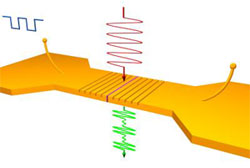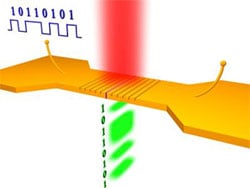
Plasmonics Harnessed to Intensify Light
A new type of light source, which makes use of the power of plasmonics, has been developed by physicists at Stanford University. The ultracompact, nanoscale device could find applications in data communications and could also be used to improve fundamental science, said the researchers.
The team took an electric-field-induced second-harmonic light generation (EFISH) device and miniaturized it to the nanoscale because EFISH devices are typically big and demand high-power lasers, large crystals and thousands of volts of electricity to produce the effect. As a result, they are impractical for all but a few applications.

Schematic showing two gold electrodes separated by a nanoslit filled with a nonlinear material. The nanoscale grating on either side of the slit directs plasmonic waves toward the slit, intensifying the light field by 80 times. A small voltage is applied to the electrodes, producing a massive electrical field across the narrow slit producing an EFISH light source. (Images: Mark Brongersma)
After the development of the first laser in 1960, scientists discovered that shining a beam through certain crystals produced light of a different color; more specifically, it produced light of exactly twice the frequency of the original. The phenomenon was dubbed second-harmonic generation.
Physicists also determined that EFISH could be obtained if an electrical field were applied to the crystals, but the beam of light produced in this manner was significantly less intense than the one produced through direct second-harmonic generation.

This schematic demonstrates how the EFISH device's dual electric and optical functions could be used to communicate data in a chip-based environment.
In the new device, “the light-matter interaction becomes nonlinear. The light you get out is different from the light you put in,” said Alok Vasudev, a graduate student and co-author of the study.
“For the first time, we have a nonlinear optical device at the nanoscale that has both optical and electrical functionality,” said co-author Wenshan Cai, a researcher in the lab of Mark Brongersma, another author. “And this offers some interesting engineering possibilities.”
“If you have two electrodes placed extremely close together, as we do in our experiment, it doesn't take many volts to produce a giant electrical field. In fact, it takes just a single volt,” said Brongersma. “It is this fundamental science that allows us to shrink the device by orders of magnitude from the human scale to the nanoscale.”
The research was published in the journal Science.
For more information, visit: www.stanford.edu
Published: September 2011